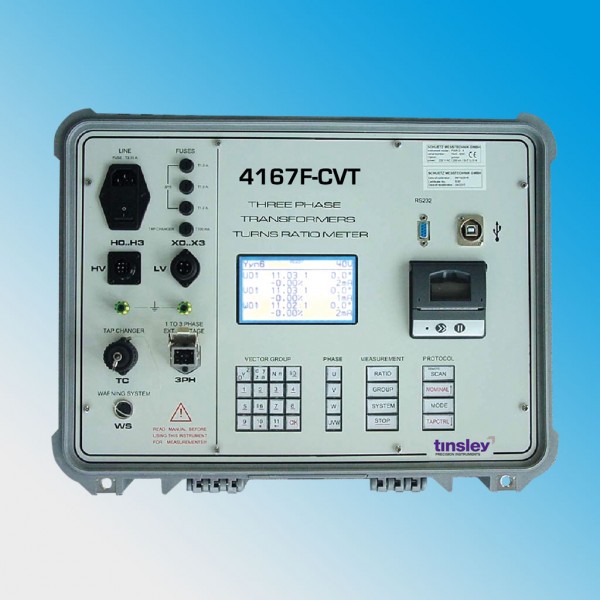Portable Transformer Ratiometer 4167F-(CVT)
Features
- Ratio range from 0.75 to 20,000 (higher ratios with CVT-Ext.)
- Fully automated measurement
- Features market unique Vector Group Detection
- Measuring voltage from 8 V to 230 V
- Measuring voltage up to 5 kV by CVT-Extension: 4167F-(CVT)
- Using 3-phase voltage for phase angles other than 0°/180°
- Easy to handle tap changer automatic
- Internal memory stores all dates (Reading with 4167F-(CVT)-XFER)
- LC display (256 x 128 pixel) with backlight
- Easy input of vectorgroup and measuring conditions
- USB/RS232C port to get full instrument control
- Centronics printer port or build in printer (optional)
- Robust mobile case for field use
- Factory Certificate
For more information about this product contact Tinsley

Overview
The great advantage of the 4167F-(CVT) compared to many of the other instruments on the market is its simple set-up.
In most cases the required parameters must be looked up in tables on the basis of the vector group and the code number of the transformer to be measured, and set up at the instrument by means of rotary switches or keys. This often results in a wrong set-up or uncertainty regarding the set-up since some of the tables are confusing.
Such a manual set-up is not necessary with the 4167F-(CVT) transformation ratio measuring instrument. You simply type in the vector group with the keys. The only thing you have to do is to connect the transformer being off-line to the device and release the measurement; all three phases are measured consecutively, all connecting and short circuited procedures at the primary and secondary voltage sides are performed automatically before each measurement. Of course it is also possible to measure just one phase, e g. H2.
An adjustable set value permits the display of an error or deviation of the measured transformation ratio. Further, an automatic control of the tap changer is provided. In this case all phases and taps are measured consecutively, and all the results are stored inside the instrument (using the transformer specific memory), printed (if a printer is connected), and transferred to the PC (if connected).
Using the internal memory all results for all taps are written to a transformer specific area. Furthermore, the transformer specific set point values, the vector group and additional information describing the transformer (e.g. serial number, location ...) are read from the memory when selected and displayed on the LCD. If set point values are present, an OK / NOT OK message with the corresponding information is displayed.
The transformer specific data can be easily programmed via a connected personal computer but it is also possible to input the transformer specific data via the internal keyboard.
The 4167F-(CVT) transformation ratio measuring instrument is connected to the H.V. and L.V. sides via four connections each. It also powers the test object at selected voltage, supplied by an internal isolating transformer. However, an external excitation using different voltages and frequencies is also possible.
A special feature is the possibility to use three phase measuring voltage. Transformers have phase angles of n*30° where n is the vector number 0 to 11. Because all measurements are single phase all results will be 0° or 180° too together with eventually phase errors.
But there are some special transformers with phase angles of n*30° ± (0°..15°), e.g. 127.5°. To get this value (and not 0/180°) one need a three phase source to feed the transformer. A 3-phase line voltage is used for this purpose.
The 4167F-(CVT) is supplied in a robust carrying case. All connections are provided at the front of the instrument and are locked in order to avoid unplugging during a measurement. An alarm set (a red lamp is on during the measurement) can also be supplied.
The connecting cables and clamps are 4-pole (Kelvin) on the HV-winding to avoid errors due to cable resistance.
